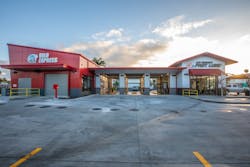Inventory Tips from a Hawaii Operation That Can Be Applied Mainland
Inventory is one of those parts of business that, if dialed in right, should run like clockwork.
But it still takes work to get there and diligence to maintain.
For Lance McQuirk, who has decades of quick lube experience under his belt, a messy inventory strategy can mean big trouble.
“Inventory is one thing that will kill your business,” he says. “Definitely one thing you have to be in control of.”
The need for an airtight inventory strategy rings true for most operations, like those that McQuirk ran in the western United States. It’s especially true 2,500 miles away in Hawaii, where he now works. For nearly everything except the bulk motor oils, he has to plan far ahead and manage that stock over long periods.
“I don't get any of that stuff locally,” he says. “That stuff comes from a supplier on the mainland. And everything that comes here comes from the supplier by boat.”
McQuirk is the director of fast lube operations for Lex Brodie’s Fast Lube, which runs two locations in Kailua-Kona and Hilo, which are both on the big island.
Managing parts and supply inventories coming by ship over a period of weeks presents its own challenges. Lots of times, it’s weather.
“Generally, from the time the boat leaves the west coast until it hits this island, it’s 12 days,” McQuirk says. “But if they get out on the west coast and a hurricane or tropical storm comes out into the pacific, that can drastically change their delivery schedule.”
That means he has to be on top of his inventory. He says that the keys to his management success in that area are easily replicable for any operation.
The Problem: Finding the Right Volume
Back on the mainland, with a distributor close by, McQuirk says that he placed orders every one or two weeks.
Now, he orders monthly. And he buys additional stock in case something happens to delay the next order.
“It does make it a bit challenging,” he says. “Not only do you have to figure normal uses, but you also have to figure if things are going to change in the next 18 days.”
That often means that he orders extra inventory items, particularly for his most popular items, in case of a supply disruption. The key is to find the right stock level. Too little, and a shop might be left exposed in the event of an unexpected supply stoppage. Ordering too much at one time can be costly.
“We do have auto parts stores here on the island,” McQuirk says. “If we were to run out of something, we could order from there, but that drastically changes our product cost.”
He keeps a close eye on his POS and inventory software systems to see how different products are moving, and he says that he stresses the importance of the system to his employees.
Shops should factor in their proximity to the distributor and know what’s possible in the event of a disruption or, alternatively, during a high-volume service period. A mainland shop may not be compensating for a trans-oceanic shipment, but the time of delivery is key to making sure the right products are in stock.
It typically takes a bit of tweaking to find the right balance. McQuirk started at the Hawaii shop six years ago and had to adjust to the factors in his supply chain.
“I think it took a year and a half or better to get the inventory really dialed in, as to how much padding to keep,” he says. “And timing-wise, what day of the week to place the order.”
Solution No. 1: Being On Time
One key to good inventory management is consistency in timing. It helps the distributor, which helps the operator get shipments just when they’re expected.
“Be very consistent on your ordering schedule,” he says. “Whether you're in the middle of the ocean, like I am, or on the mainland. Being consistent with your order date definitely helps with inventory stock levels.”
That’s one way to streamline the process. It also makes the volume equation much easier, because with time, shops will be able to look back on the same time last year and compare orders.
“If you're going to do a usage-based report from your computer system, and one month you order on the fifth and the next month you order on the 25th, the order size is going to be different,” McQuirk says.
Solution No. 2: Team Effort
Inventory takes all hands, and it’s important that the techs who pull inventory from the shelf every day know how to keep things organized and logged into the point-of-sale system.
Training on the inventory systems is just the start. McQuirk says that it’s best to let employees know how much the operation hinges on smooth inventory management.
One way to do that is to rotate those duties in the shop.
“Give different employees different tasks when it comes to the inventory,” he says. “Whether it’s rotating stock, receiving a warehouse order or entering the inventory into the computer.”
Of course, the buck stops with the manager. McQuirk says that he’s careful to train himself to keep a close eye on stock levels. Practice makes perfect.
“I go through my inventory, the different categories, weekly rather than monthly,” he says. “Rotate everything shelf-wise. A lot of operators will do an inventory once per month. I do mine weekly.”
About the Author
Matt Hudson
Content Director
Matt Hudson is the former content director for National Oil and Lube News.

